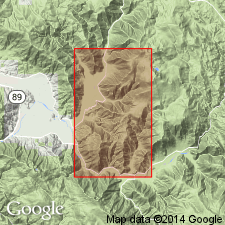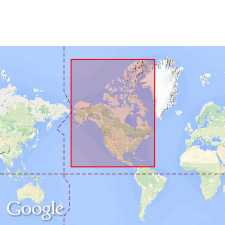
- Usage in publication:
-
- Lilac formation
- Modifications:
-
- Named
- Dominant lithology:
-
- Sandstone
- Argillite
- AAPG geologic province:
-
- Sierra Nevada province
Summary:
[Derivation of name not given]. [Author has renamed rocks of Lower Jurassic Trail formation of Diller (1892), "Lilac formation". Trail formation (tuff and conglomerate) is Late Jurassic and next to youngest Jurassic formation, Combe Formation (new) in Taylorsville region in this paper]. Lilac formation is also referred to as Lilac sandstone and Lilac argillite. Occurs at various separate localities along west base of Mount Jura and elsewhere. Consists of calcareous, dark-gray sandstone and argillite. Is 725 ft thick. Contains middle Early Jurassic fossils; lower zone EUCCHIOCERAS EXOLETUM n. sp.; upper zone, PARAPECTEN PRAECURSOR n. sp. "Rests on Middle Triassic volcanics, the oldest rocks in the Mount Jura column." p.897. Underlies Hardgrave formation.
Source: GNU records (USGS DDS-6; Menlo GNULEX).

- Usage in publication:
-
- Lilac Argillite*
- Modifications:
-
- Adopted
- Biostratigraphic dating
- AAPG geologic province:
-
- Sierra Nevada province
Summary:
Lilac Argillite of Crickmay (1933) adopted. Correlation chart shows unit is gray sandstone and mudstone with dacite flows and tuff (total thickness of 725 ft). Overlies volcanic rocks of uncertain age; underlies Hardgrave Sandstone. Age is Early Jurassic (Sinemurian) based on ammonite ECHIOCERAS in association with WEYLA ALATA (von Buch).
Source: GNU records (USGS DDS-6; Menlo GNULEX).
For more information, please contact Nancy Stamm, Geologic Names Committee Secretary.
Asterisk (*) indicates published by U.S. Geological Survey authors.
"No current usage" (†) implies that a name has been abandoned or has fallen into disuse. Former usage and, if known, replacement name given in parentheses ( ).
Slash (/) indicates name conflicts with nomenclatural guidelines (CSN, 1933; ACSN, 1961, 1970; NACSN, 1983, 2005, 2021). May be explained within brackets ([ ]).

